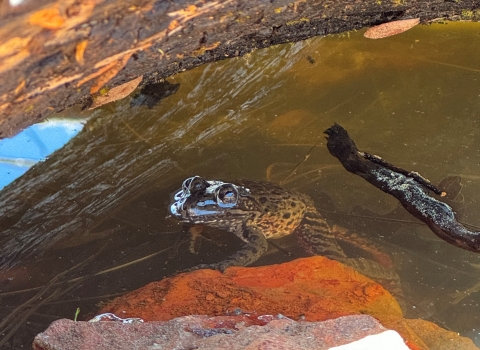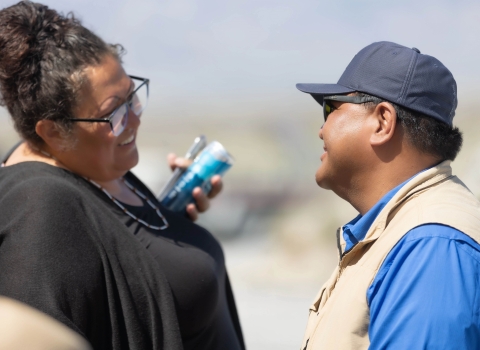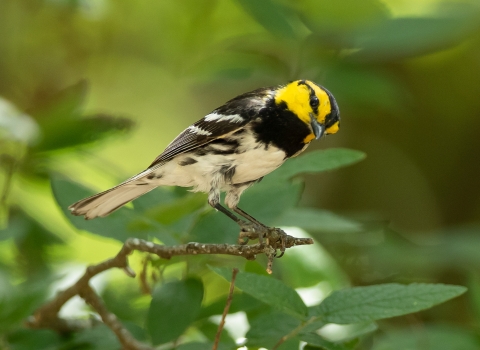Migratory Bird Joint Ventures: Marking 25 Years of Partnerships for Bird Conservation
Service, Joint Ventures Honor Conservation Champions
On March 21, federal and state agencies, nongovernment organizations and Members of Congress came together with partners from across North America to celebrate 25 years of the innovative partnerships for bird and habitat conservation known as migratory bird Joint Ventures.
Since the landmark North American Waterfowl Management plan called for the establishment of Joint Ventures in 1986, they have emerged as the international model for partnership-driven conservation. Joint Ventures bring together private landowners, hunters, birdwatchers, tribes, non-profit organizations, universities, government agencies and industry to cooperate in the planning and implementation of projects to conserve and enhance bird habitat.
At a Capitol Hill reception, the Joint Ventures presented awards to several key partners, recognizing their efforts as “Conservation Champions” who have supported collaborative conservation efforts over the past two and a half decades.
Starting with just three Joint Ventures in 1987, more than two dozen now cover the North American landscape from the far northwestern boreal forest of Canada to the Florida Keys and into Mexico. Guided by the bird conservation initiatives, Joint Ventures have expanded their work to include not only waterfowl, but landbirds, shorebirds, waterbirds, and game birds, while adapting in other ways to address emerging challenges.
This year marks the 25th anniversary of the Joint Ventures. During this time, Joint Venture partners have conserved nearly 16 million acres of critical wildlife habitat.
“For 25 years, migratory bird Joint Ventures have worked to protect and restore landscapes that support healthy bird populations, sustain livelihoods, and provide nature’s benefits to people and wildlife,” said Secretary of the Interior Ken Salazar. “We share a vision of a landscape where native birds thrive, and we believe that our well-being depends on healthy lands, waters, and wildlife. By bringing together diverse partners, Joint Ventures protect the landscapes that birds, and people, rely upon.”
Joint Ventures bring partners together to protect and restore landscapes that support healthy bird populations, sustain livelihoods, and provide nature’s benefits to people and wildlife. Using state-of-the-art science, the joint ventures have worked together to ensure that diverse habitats are available for birds and other wildlife.
Effective, collaborative conservation for birds is needed now more than ever. More than 30 percent of bird species in the United States are federally listed as endangered, threatened or of conservation concern. Their greatest threat is habitat loss on breeding areas, overwintering grounds, and migration sites throughout North America and beyond.
“The work of the Joint Ventures is critical to protecting and restoring North American bird populations and habitats. These science-driven partnerships have greatly improved our ability to deliver conservation at a continental scale,” said Dan Ashe, Director of the U.S. Fish and Wildlife Service.
Organizations and individuals honored as “Conservation Champions” by the Joint Ventures include:
Ducks Unlimited, Inc. and Ducks Unlimited Canada
Ducks Unlimited, Inc. and Ducks Unlimited Canada have been integral partners, advocates, and leaders in the development and maturation of Joint Ventures from their inception, investing enormous amounts of staff time and funding in the organization, administration, and operation of Joint Ventures. DU has been a consistently active partner in Joint Venture planning, design, delivery, research, and monitoring, all of which are critically important to effective bird habitat conservation.
Association of Fish and Wildlife Agencies
From the beginning, some 25 years ago, state fish and wildlife agencies have served as foundational members of Joint Ventures. Today, with Joint Ventures essentially covering the entire United States and Canada, state fish and wildlife agencies or their Canadian counterparts, serve on every Joint Venture Management Board. The same can be said for their participation on Joint Venture Technical Committees.
ConocoPhillips
ConocoPhillips has been a champion of migratory bird conservation through their involvement with Joint Ventures by donating critical non-federal funding, serving on Management Boards and setting an exemplary standard to the rest of corporate America. In all of these pursuits they have been committed, long-term partners.
Gary Myers
Gary Myers is the Retired (Emeritus) Director of the Tennessee Wildlife Resource Agency. After the North American Waterfowl Management Plan was signed in 1986 and called for the establishment of Joint Ventures to implement waterfowl habitat conservation, Gary set the standard for what a Joint Venture would look like and how they would function. He directly helped set up the Lower Mississippi Valley and Gulf Coast Joint Ventures in 1987 and 1988, respectively. When the Joint Ventures broadened their focus to include all bird groups, a decision in which Gary was extremely influential, he was key in the development of the Central Hardwoods Joint Venture, one of the first Joint Ventures to be formed with this “all-bird” approach. More broadly, Gary was an advocate for Joint Ventures across the continent and pushed for “wall-to-wall” Joint Ventures across the nation.
The Pingree Family
In 1820, the Pingree family made large investments in Maine timberlands. Today, they are one of the ten largest private landowners in the United States, owning nearly one million acres of Maine timberland. The Pingrees have accomplished two ground-breaking conservation efforts on their land. In 1993, the family initiated an independent, third-party green-certification of their forestland to the highest international standards. These efforts resulted in the Pingree’s Seven Islands Land Company becoming the world’s largest third-party certified sustainable forest products company.
Clen Atchley
Clen Atchley served on the Intermountain West Joint Venture Management Board for 16 years, one of the longest stints for any private landowner on a Joint Venture Board. He provided instrumental leadership to the Joint Venture community by bringing the voice of a working farmer and rancher to Joint Venture discussions and decisions. He is a proven conservation leader with a vast array of habitat conservation accomplishments on his own farm and ranchland, as well as through active engagement with the Teton Regional Land Trust for many years.
Scott and Susan Freeman and Family
Pacific Coast Joint Venture partners have been working with the Scott and Susan Freeman on the Tarboo Watershed since 2004. Over the past eight years, the Freemans have completed five conservation purchases and now own 232 acres of wetland and forest along Tarboo Creek, a tributary to the state of Washington’s Hood Canal. They also actively work to restore land as part of the larger effort to protect and restore Tarboo Creek. They have involved their two sons and various relatives and friends in planting and weed control projects over the years.
Grassland Resource Conservation District
The Grassland RCD is located within the Grassland Ecological Area, the largest contiguous block of wetlands west of the Mississippi River. Located in the heart of the Pacific Flyway, the District comprises 75,000 acres of wetlands, riparian riparian
Definition of riparian habitat or riparian areas.
Learn more about riparian , and associated upland habitats, and hosts some of the greatest concentrations of waterfowl and shorebirds on earth. The 162 private duck clubs and over 2,000 member hunters of the Grassland Resource Conservation District have worked with Central Valley Joint Venture partners for nearly 25 years, primarily as contributors and beneficiaries of North American Wetland Conservation Act grants. Those grants have protected, restored, and enhanced tens of thousands of acres of bird habitat, which also host a wide range of other wildlife.
“The Wetlands LLC” Danny Graham, Ronny Graham, Ronnie Myrick
Ronny Graham, Danny Graham, and Ronnie Myrick own the “The Wetlands LLC,&rdquo,500 acres of intensively managed wetlands located in Caldwell Parish, La. They are dedicated to wetland and natural resource conservation, as evidenced by their continued involved with various conservation programs in support of Lower Mississippi Valley Joint Venture goals. They have entered into several private landowner agreements, including the Louisiana private lands program, which has been an integral part of the Lower Mississippi Valley Joint Venture habitat conservation effort over the past two decades.
For more information about the accomplishments of the Joint Ventures and their many partners, visit http://www.fws.gov/birdhabitat/jointventures.
On March 21, federal and state agencies, nongovernment organizations and Members of Congress came together with partners from across North America to celebrate 25 years of the innovative partnerships for bird and habitat conservation known as migratory bird Joint Ventures.
Since the landmark North American Waterfowl Management plan called for the establishment of Joint Ventures in 1986, they have emerged as the international model for partnership-driven conservation. Joint Ventures bring together private landowners, hunters, birdwatchers, tribes, non-profit organizations, universities, government agencies and industry to cooperate in the planning and implementation of projects to conserve and enhance bird habitat.
At a Capitol Hill reception, the Joint Ventures presented awards to several key partners, recognizing their efforts as “Conservation Champions” who have supported collaborative conservation efforts over the past two and a half decades.
Starting with just three Joint Ventures in 1987, more than two dozen now cover the North American landscape from the far northwestern boreal forest of Canada to the Florida Keys and into Mexico. Guided by the bird conservation initiatives, Joint Ventures have expanded their work to include not only waterfowl, but landbirds, shorebirds, waterbirds, and game birds, while adapting in other ways to address emerging challenges.
This year marks the 25th anniversary of the Joint Ventures. During this time, Joint Venture partners have conserved nearly 16 million acres of critical wildlife habitat.
“For 25 years, migratory bird Joint Ventures have worked to protect and restore landscapes that support healthy bird populations, sustain livelihoods, and provide nature’s benefits to people and wildlife,” said Secretary of the Interior Ken Salazar. “We share a vision of a landscape where native birds thrive, and we believe that our well-being depends on healthy lands, waters, and wildlife. By bringing together diverse partners, Joint Ventures protect the landscapes that birds, and people, rely upon.”
Joint Ventures bring partners together to protect and restore landscapes that support healthy bird populations, sustain livelihoods, and provide nature’s benefits to people and wildlife. Using state-of-the-art science, the joint ventures have worked together to ensure that diverse habitats are available for birds and other wildlife.
Effective, collaborative conservation for birds is needed now more than ever. More than 30 percent of bird species in the United States are federally listed as endangered, threatened or of conservation concern. Their greatest threat is habitat loss on breeding areas, overwintering grounds, and migration sites throughout North America and beyond.
“The work of the Joint Ventures is critical to protecting and restoring North American bird populations and habitats. These science-driven partnerships have greatly improved our ability to deliver conservation at a continental scale,” said Dan Ashe, Director of the U.S. Fish and Wildlife Service.
Organizations and individuals honored as “Conservation Champions” by the Joint Ventures include:
Ducks Unlimited, Inc. and Ducks Unlimited Canada
Ducks Unlimited, Inc. and Ducks Unlimited Canada have been integral partners, advocates, and leaders in the development and maturation of Joint Ventures from their inception, investing enormous amounts of staff time and funding in the organization, administration, and operation of Joint Ventures. DU has been a consistently active partner in Joint Venture planning, design, delivery, research, and monitoring, all of which are critically important to effective bird habitat conservation.
Association of Fish and Wildlife Agencies
From the beginning, some 25 years ago, state fish and wildlife agencies have served as foundational members of Joint Ventures. Today, with Joint Ventures essentially covering the entire United States and Canada, state fish and wildlife agencies or their Canadian counterparts, serve on every Joint Venture Management Board. The same can be said for their participation on Joint Venture Technical Committees.
ConocoPhillips
ConocoPhillips has been a champion of migratory bird conservation through their involvement with Joint Ventures by donating critical non-federal funding, serving on Management Boards and setting an exemplary standard to the rest of corporate America. In all of these pursuits they have been committed, long-term partners.
Gary Myers
Gary Myers is the Retired (Emeritus) Director of the Tennessee Wildlife Resource Agency. After the North American Waterfowl Management Plan was signed in 1986 and called for the establishment of Joint Ventures to implement waterfowl habitat conservation, Gary set the standard for what a Joint Venture would look like and how they would function. He directly helped set up the Lower Mississippi Valley and Gulf Coast Joint Ventures in 1987 and 1988, respectively. When the Joint Ventures broadened their focus to include all bird groups, a decision in which Gary was extremely influential, he was key in the development of the Central Hardwoods Joint Venture, one of the first Joint Ventures to be formed with this “all-bird” approach. More broadly, Gary was an advocate for Joint Ventures across the continent and pushed for “wall-to-wall” Joint Ventures across the nation.
The Pingree Family
In 1820, the Pingree family made large investments in Maine timberlands. Today, they are one of the ten largest private landowners in the United States, owning nearly one million acres of Maine timberland. The Pingrees have accomplished two ground-breaking conservation efforts on their land. In 1993, the family initiated an independent, third-party green-certification of their forestland to the highest international standards. These efforts resulted in the Pingree’s Seven Islands Land Company becoming the world’s largest third-party certified sustainable forest products company.
Clen Atchley
Clen Atchley served on the Intermountain West Joint Venture Management Board for 16 years, one of the longest stints for any private landowner on a Joint Venture Board. He provided instrumental leadership to the Joint Venture community by bringing the voice of a working farmer and rancher to Joint Venture discussions and decisions. He is a proven conservation leader with a vast array of habitat conservation accomplishments on his own farm and ranchland, as well as through active engagement with the Teton Regional Land Trust for many years.
Scott and Susan Freeman and Family
Pacific Coast Joint Venture partners have been working with the Scott and Susan Freeman on the Tarboo Watershed since 2004. Over the past eight years, the Freemans have completed five conservation purchases and now own 232 acres of wetland and forest along Tarboo Creek, a tributary to the state of Washington’s Hood Canal. They also actively work to restore land as part of the larger effort to protect and restore Tarboo Creek. They have involved their two sons and various relatives and friends in planting and weed control projects over the years.
Grassland Resource Conservation District
The Grassland RCD is located within the Grassland Ecological Area, the largest contiguous block of wetlands west of the Mississippi River. Located in the heart of the Pacific Flyway, the District comprises 75,000 acres of wetlands, riparian riparian
Definition of riparian habitat or riparian areas.
Learn more about riparian , and associated upland habitats, and hosts some of the greatest concentrations of waterfowl and shorebirds on earth. The 162 private duck clubs and over 2,000 member hunters of the Grassland Resource Conservation District have worked with Central Valley Joint Venture partners for nearly 25 years, primarily as contributors and beneficiaries of North American Wetland Conservation Act grants. Those grants have protected, restored, and enhanced tens of thousands of acres of bird habitat, which also host a wide range of other wildlife.
“The Wetlands LLC” Danny Graham, Ronny Graham, Ronnie Myrick
Ronny Graham, Danny Graham, and Ronnie Myrick own the “The Wetlands LLC,&rdquo,500 acres of intensively managed wetlands located in Caldwell Parish, La. They are dedicated to wetland and natural resource conservation, as evidenced by their continued involved with various conservation programs in support of Lower Mississippi Valley Joint Venture goals. They have entered into several private landowner agreements, including the Louisiana private lands program, which has been an integral part of the Lower Mississippi Valley Joint Venture habitat conservation effort over the past two decades.
For more information about the accomplishments of the Joint Ventures and their many partners, visit http://www.fws.gov/birdhabitat/jointventures.


